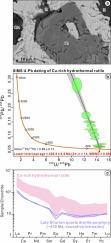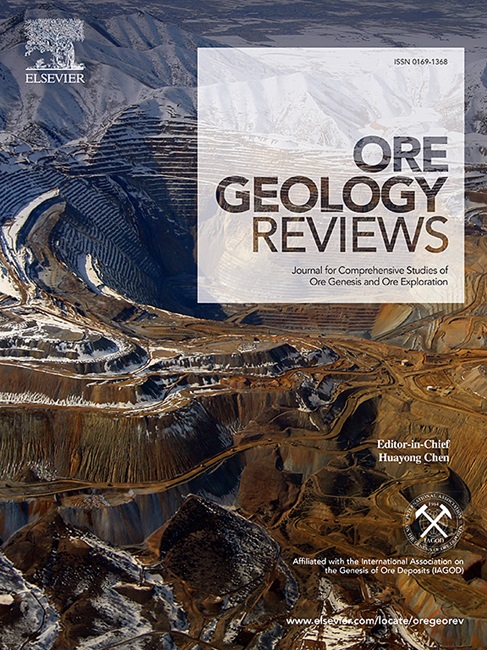Hydrothermal rutile chemistry and U-Pb age fingerprinting of the formation of the giant Nurkazgan porphyry Cu-Au deposit, Central Kazakhstan
IF 3.2
2区 地球科学
Q1 GEOLOGY
引用次数: 0
Abstract
The porphyry Cu-related intrusions commonly comprise multiple phases such as the large Nurkazgan porphyry Cu-Au deposit in Central Kazakhstan, hosted in the Karagandinsky dioritic to granitic intrusive complex. Here, SHRIMP and LA-ICP-MS zircon U-Pb dating on the multiple ore-bearing intrusions from this complex confirms a punctuated magmatic history distributed over 35 m.y., and marked by three episodic porphyry events rather than a single event, with the oldest event being the early granodiorite and quartz diorite porphyries at ca. 437–440 Ma, the second being the quartz diorite porphyry at 429.7 ± 2.1 Ma, and the last being the late granodiorite and quartz diorite porphyries at 402.8 ± 3.7 Ma and 402.0 ± 3.9 Ma, respectively. The mineralization is related to the two younger episodic intrusions of quartz diorite porphyry at ∼ 430 Ma and ∼ 402 Ma, respectively. SIMS U-Pb dating of hydrothermal, Cu-rich (up to 20.9 ppm) rutile from the breccia-type ores directly constrains the timing of porphyry mineralization at 428.9 ± 6.9 Ma, which is coincident with the emplacement age of the ∼ 430 Ma quartz diorite porphyry, and thus demonstrates this porphyry as a causative intrusion generating main-stage mineralization. This close genetic link is also supported by the chondrite-normalized REE patterns of rutile, which show remarkably similar light REE-enrichments and moderate negative Eu anomalies to those of the ∼ 430 Ma quartz diorite porphyry. A molybdenite sample obtained from the main-ore stage vein, however, has a Re-Os age of 418.6 ± 1.8 Ma, which is slightly younger than the U-Pb age determinations of rutile. This indicates that the Re-Os isotope system was disturbed by the second (post-ore) thermal event related to ∼ 402 Ma quartz diorite porphyry. In line with published data, this study suggests that the rutile U-Pb age in combination with its REE patterns can be a powerful tool to trace the causative porphyry. Moreover, the typical LREE-enriched REE patterns coupled with the high Cu anomalies, inherited from the causative porphyry and related exsolving fluids, can be as diagnostic proxies for distinguishing the porphyry Cu-related hydrothermal rutile from those formed in orogenic gold deposits. Based on these two geochemical discriminators and U-Pb ages, rutile can serve as unique fingerprints to help improve porphyry copper exploration in green field or covered terranes to complement detrital zircon fertility indicators.

哈萨克斯坦中部 Nurkazgan 巨大斑岩型铜金矿床形成过程中的热液金红石化学和 U-Pb 年龄指纹图谱
与斑岩铜有关的侵入体通常由多个阶段组成,如位于哈萨克斯坦中部的大型 Nurkazgan 斑岩铜金矿床,就坐落在卡拉甘金斯基闪长岩至花岗岩侵入体复合体中。在这里,对这一复合体中的多个含矿侵入体进行的 SHRIMP 和 LA-ICP-MS 锆石 U-Pb 测定证实了一个分布于 35 m.y. 的点状岩浆史,其特征是三个偶发斑岩事件而非单一事件,最古老的事件是早期花岗闪长岩和石英闪长岩斑岩,时间约为 437-440 Ma.最古老的事件是约 437-440 Ma 的早期花岗闪长岩和石英闪长岩斑岩,第二个是 429.7 ± 2.1 Ma 的石英闪长岩斑岩,最后一个是分别为 402.8 ± 3.7 Ma 和 402.0 ± 3.9 Ma 的晚期花岗闪长岩和石英闪长岩斑岩。矿化与石英闪长岩斑岩的两个较年轻的偶发侵入体有关,时间分别为 ∼ 430 Ma 和 ∼ 402 Ma。从角砾岩型矿石中提取的热液富铜(高达百万分之 20.9)金红石的 SIMS U-Pb 定年直接确定了斑岩成矿的时间为 428.9 ± 6.9 Ma,这与∼ 430 Ma 的石英闪长岩斑岩的成岩年龄相吻合,从而证明了该斑岩是产生主要阶段成矿作用的成因侵入体。金红石的软玉归一化 REE 模式也证明了这种密切的遗传联系,该模式与 430 Ma∼ 石英闪长岩斑岩的轻度 REE 富集和中度负 Eu 异常极为相似。然而,从主矿阶段矿脉中获得的辉钼矿样品的Re-Os年龄为418.6 ± 1.8 Ma,比金红石的U-Pb年龄测定结果稍早。这表明,Re-Os同位素系统受到了与∼ 402 Ma石英闪长斑岩有关的第二次(矿石后)热事件的干扰。与已发表的数据一致,这项研究表明,金红石的U-Pb年龄与其REE模式相结合,可以成为追踪成因斑岩的有力工具。此外,典型的 LREE 富集 REE 模式与高铜异常(由成因斑岩和相关外溶解流体继承)可作为诊断代用指标,用于区分斑岩铜相关热液金红石与成因金矿床中形成的金红石。根据这两个地球化学判别因素和 U-Pb 年龄,金红石可以作为独特的指纹,帮助改进绿地或覆盖地层中的斑岩铜矿勘探,以补充碎屑锆石肥度指标。
本文章由计算机程序翻译,如有差异,请以英文原文为准。
求助全文
约1分钟内获得全文
求助全文
来源期刊

Ore Geology Reviews
地学-地质学
CiteScore
6.50
自引率
27.30%
发文量
546
审稿时长
22.9 weeks
期刊介绍:
Ore Geology Reviews aims to familiarize all earth scientists with recent advances in a number of interconnected disciplines related to the study of, and search for, ore deposits. The reviews range from brief to longer contributions, but the journal preferentially publishes manuscripts that fill the niche between the commonly shorter journal articles and the comprehensive book coverages, and thus has a special appeal to many authors and readers.
 求助内容:
求助内容: 应助结果提醒方式:
应助结果提醒方式:


